Misano was yet another MotoGP race of surprises: That Fabio Quartararo is now able to keep the pace race long; that Maverick Viñales bumped provisional surprise pole sitter Pol Espargaró to top qualifying; and that Marc Márquez showed heat in putting an end to being himself beaten on the last lap. Need more? This racetrack, never easy for Yamaha, delivered four top placings, second through fifth.
At the start, Viñales led for two laps, then slowed, being passed by Quartararo and Márquez. Quartararo then led with Márquez right behind. Viñales, as in some previous races, recovered pace but could not reach the lead pair. Valentino Rossi, having moved to fourth with difficulty, was back some 10 seconds. Márquez attacked from the start of the last lap, was repassed, and the brief battle was won by Márquez as Quartararo had to lift at a point. The finish was one Honda followed by the Yamahas of Quartararo, Viñales, Rossi, and Franco Morbidelli.
How could the Yamahas be transformed in this way? A few months ago, the track was “microblasted,” cleaned of its rubber burden by hammering with very fine steel shot. This turned the track surface white from its former dark to black and completely changed its traction character, slowing lap times in comparison with last year.
We have seen something similar when tracks carry fine dust. At Losail in Qatar, the fines have the effect of denying traction its molecular aspect of rubber literally sticking to pavement, leaving only the mechanical aspect of grip, of rubber filling the pavement texture and generating grip dynamically as texture plows through rubber like a fleet of microships, each “hull” generating the drag that is tire grip.
To a lesser extent, we see something similar when there has been recent rain that washes loose rubber out of the texture, leaving the riders to confidently predict a return of grip and lap time as soon as enough bikes and laps have replaced the rubber.
Yet this is different again because normally Yamahas go well only when there is good grip. In this case, grip was down but every Ducati and every Honda but that of Márquez was put off the pace by the change. Yet all the Yamahas performed well.
Viñales said, “I am really happy because from Friday I felt really good, and somehow I found a better feeling than I had at the test [two weeks earlier], so I can hit very good lap times even with very used tires.”
On Friday, Quartararo said, “Today I make many small moments with the front, and the positive thing is that we can feel when we are losing the front; it’s not just really aggressive and I crash. So today I was pushing to try to brake really hard and feel the limit on the front. I felt it, so that’s something really great. We don’t have grip on the track, but I feel the limit.” Being able to sense that limit enabled him to safely maximize what corner speed was possible.
What distinguishes the Yamahas from the Ducatis and Hondas? The Yamahas track rather than slide through fast corners, while the styles of the Ducati and Honda men depend more on sliding. Many riders were losing the front through practice and there were a number of falls in the race but not by the Yamaha men. Whatever the change in the pavement, the Yamaha men were better able to “hear” the messages from their tires being ridden in their style than were the others. Quartararo found a way to detect the onset of losing front grip and riding within that limit could run very fast through long corners like 11.
Quartararo’s Petronas Yamaha teammate Morbidelli said of him, “Fabio is able to take the fast corners at a very high speed and with very little effort.” What does little effort mean? It meant that he was making few visible corrections. His ability to know just how far to push the front tire enabled him to do this reliably.
Márquez evidently could not muster the extra to attempt a pass on Quartararo until the last lap, and he did not make the decision to do so until then. “He is riding in a very good way—very precise—but especially at the fast corners he is very fast,” Márquez said. “I tried to overtake him before sector 3 because, if I arrived behind him before turn 11, I would lose the race as he was very fast in the fast corners. Even with a slipstream, I was not able to follow him.”
For that reason, once Márquez had decided to attack rather than finish second a third time in three consecutive race weekends, he began the attack at turn 1. Quartararo later described Márquez’s engine as “like an airplane,” but pass and repass followed until Márquez was able to squeeze Quartararo out at turn 14, forcing him to sit up to avoid contact.
Quartararo said, “I don’t think Marc wore his tires out much, and on the last lap he performed really well.” He was delighted to have battled with Márquez to the end and gained more valuable experience, saying, “Today is the best day of my life.”
Márquez said, “I predict next year he will be a tough contender for the championship. Fabio today is the winner or the best rider in the race as he led all of the race.”
In the tire briefing, Michelin’s Piero Taramasso said the microblasting “increases tire consumption, is very aggressive on the tire.” Non-Yamaha riders other than Marquez were defeated by this, as their riding styles’ dependence upon sliding perhaps overworked the surface layer of rubber, degrading its grip. Ducati’s Danilo Petrucci, who has been impressively fast elsewhere, was desperate: “For everything we improve, we worsen another. Nothing works.” He was a discouraging 10th, half a minute behind Márquez and Quartararo.
Andrea Dovizioso, sixth on Sunday and still second in the championship, said, “We all suffered because of the very little grip, especially at the front. I rode trying to be as relaxed as possible. The asphalt this weekend required a riding style that is usually not required. This bike isn’t used to that.”
Cal Crutchlow, who crashed out, said, “I didn’t have a good feeling in the test, and I didn’t have a good feeling all weekend here.”
This season more than any other has revealed the extent to which seemingly small changes in pavement—wind carrying fine Saharan dust across the Mediterranean, Misano being de-rubbered—can provoke large shifts in the relative competitiveness of bikes. I believe this tells us that increasingly, as bikes are optimized, their performance depends upon smaller differences.
There may be another effect in play here. Surely the riders who depend heavily upon sliding learn to read tire signals through that lens, while those whose tires spend more time tracking rather than sliding are depending upon quite different messages. Some riders are clearly conscious of these messages, but others, such as Johann Zarco, say they don’t like to think too much about what they do for fear that will stop their “music.”
This makes me remember that the first anti-wheelie systems were triggered by excess front ride height. The next step was to measure the velocity of that rise, and now that inertial measuring units (IMUs) are doing the detecting, they are triggering from the rate of acceleration of pitch-up. How do riders perceive tire messages? What is message and what is noise? How do they separate them? Kalman filtering, anyone? Whatever Quartararo discovered at Misano worked well.
There is a lively rubber-removal industry now that mainly serves commercial airports. Each time a wide-body airliner touches down, it deposits roughly 20 pounds of rubber from its tires, liquefied and then polymerized by the heat of spin up—we see the smoke—into a hard, glassy surface that greatly reduces directional stability and grip when wet. Therefore, as often as weekly if the runway handles 200 or more landings per day, high-pressure (1,000–2,500 atmospheres) water jets are used to de-rubber the touchdown zones.
Taramasso revealed that on its own test surfaces Michelin use microblasting with fine shot every seven to eight years. For the first five to seven months after this, grip is reduced, after which it returns to normal. The fine shot renews the micro edges of pavement aggregate much as application of a trueing diamond to an abrasive wheel removes grains dulled by work. This fresh surface is what is very aggressive on the tire.
Now onward to Motorland Aragón in Spain and possibly to a fresh “butterfly effect” that may restack the odds yet again.











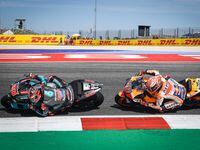
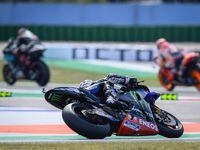
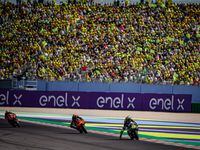
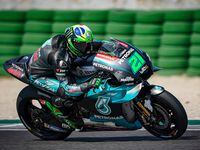
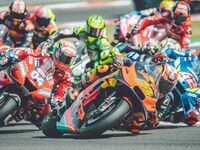
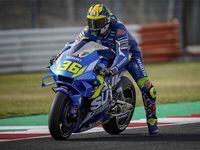
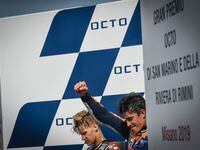
/cloudfront-us-east-1.images.arcpublishing.com/octane/RO36KTIVYZEATJW7CCB77EQHLQ.jpg)
/cloudfront-us-east-1.images.arcpublishing.com/octane/BUIUXSLF5RFRVJ3E26VRO5V2AY.jpg)
/cloudfront-us-east-1.images.arcpublishing.com/octane/EJJ2JBBSEZAWLFCRDALQOIBFVU.jpg)
/cloudfront-us-east-1.images.arcpublishing.com/octane/WVYKJFMINVFMFH37AE4OUEWVIM.jpg)

/cloudfront-us-east-1.images.arcpublishing.com/octane/JJ3MC6GNDFF5ZNYD3KD3E4EY7Y.jpg)
/cloudfront-us-east-1.images.arcpublishing.com/octane/XH2ETEU4NVGDFNQO2XT2QQS5LU.jpg)
/cloudfront-us-east-1.images.arcpublishing.com/octane/UFG652C27BDBFPK42TDAJ5CMX4.jpg)
/cloudfront-us-east-1.images.arcpublishing.com/octane/AUE3NFVRRZDSBIDVUGIYIDQNUI.jpg)
/cloudfront-us-east-1.images.arcpublishing.com/octane/LYR62CH2WNBMHJJVXVATZHOUE4.jpg)
/cloudfront-us-east-1.images.arcpublishing.com/octane/RBCTRGBQYBDK7A6XPG3HKPS7ZQ.jpg)
/cloudfront-us-east-1.images.arcpublishing.com/octane/MQXQRYMZVBCWJIRYP3HEN3SHVE.jpg)
/cloudfront-us-east-1.images.arcpublishing.com/octane/TSPODNNEWRDSVJGUCNQTDG4ADI.jpg)
/cloudfront-us-east-1.images.arcpublishing.com/octane/X5TB7BDV4BA2RPSY54ZGK27RP4.jpg)
/cloudfront-us-east-1.images.arcpublishing.com/octane/REUHOJXRDBGZ5IHBYZCCBCISPA.jpg)
/cloudfront-us-east-1.images.arcpublishing.com/octane/52LGJTCKBFEHDF7S7H4CVUIMGM.jpg)
/cloudfront-us-east-1.images.arcpublishing.com/octane/YMWAIPIPSJAOXOU3QMJMGH37OM.jpg)


/cloudfront-us-east-1.images.arcpublishing.com/octane/EJ6KZRGAYBCVXNL2PJXL37UVWQ.jpg)
/cloudfront-us-east-1.images.arcpublishing.com/octane/AAN4TI76M5H5JMUVEIGASWXBDU.jpg)
/cloudfront-us-east-1.images.arcpublishing.com/octane/P3RXD2UCPFF37CMB7CHPVKXORY.jpg)
/cloudfront-us-east-1.images.arcpublishing.com/octane/VZEG2EJI2RDFZNHLRZMU56MD3Q.jpg)
/cloudfront-us-east-1.images.arcpublishing.com/octane/GVJQO5FFOFBWNGODOBRB4FBAW4.jpg)